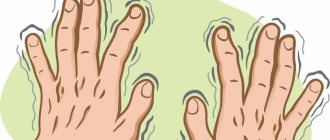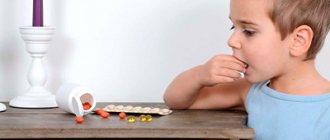Hallucinations in older people are sensory, visual, auditory, tactile, olfactory or complex sensations that do not exist in reality and are the product of the patient’s brain. Observed in mental disorders, degenerative and vascular diseases, and other cerebral pathologies. Often occur after an ischemic or hemorrhagic stroke.
To schedule a consultation, call 8(969)060-93-93.
Causes
The pathological condition is of a polyetiological nature. Why do older people hallucinate:
- Neurological, mental and somatic pathologies : schizophrenia, epilepsy, post-stroke condition, severe cerebral atherosclerosis, trauma, neoplasms and inflammatory diseases of the brain, endocrine and metabolic disorders, endogenous intoxications. A common cause is senile dementia.
- Taking medications. Elderly people may be prescribed medications that affect the psyche: psychostimulants, tranquilizers, anticonvulsants, antituberculosis, antiviral and antibacterial agents. Hallucinations usually occur with an overdose or prolonged use of drugs. A significant role is played by forgetfulness, which contributes to repeated taking of pills, and neglect of the doctor’s recommendations regarding dosage.
- Isolation, lack of sensory impressions. Old people are often alone for long periods of time. The brain, suffering from a lack of sensations, begins to create something non-existent to fill the void. This effect is especially pronounced in cases of severe impairment of the functions of the sensory organs - complete or almost complete blindness and deafness.
- Chronic sleep disorders . Insomnia, nightmares, late falling asleep and early awakenings lead to overwork and psycho-emotional exhaustion. Distorted perception of the environment and short-term illusions due to lack of sleep are observed even in young people. In old age, these phenomena are aggravated due to concomitant diseases and disorders of the brain.
How else can you help an old person suffering from hallucinations?
In alternative medicine, there are alternative methods that help eliminate hallucinosis. Traditional healers believe that decoctions of herbs, such as comfrey, mignonette, oregano, valerian, and zuznik, have proven themselves well.
Psychiatrists discourage taking these medications for treatment because there is no scientific evidence to show they work. In addition, the side effects that arise from them often outweigh all the benefits.
As an alternative or harmonious addition to the main therapy, there are other ways to treat hallucinations. Much depends on how the patient’s daily routine is organized. Old people suffering from hallucinatory mental disorders are advised to adjust their regimen:
- distribute daytime time so that routine activities are performed at the same hour, and in free intervals do “business”;
- you need to walk every day;
- for physically active people, increase the load a little (run in the morning, do exercises, etc.);
- communicate a lot with relatives, neighbors, friends;
- regularly ventilate the room;
- always maintain order and cleanliness in the house;
- avoid negative phenomena (quarrels, sad films and music).
For old people with reality perception disorders, support from close relatives is very important. After all, the first reason for the occurrence of pathology is a lack of communication and attention.
In conclusion. Psychologists say that with modern developments in medicine, it is impossible to completely cure hallucinations in old people. But this is unlikely to be easy to do in the future, since this disease is caused by irreversible changes occurring in the body of older people. The main goal of therapy is to identify the root causes of hallucinations and influence them with medications.
Classification
Hallucinations can be true or false. In the first case, non-existent sounds, visual images, etc. look as reliable as really existing objects of the surrounding world, and are felt as perceived by the senses. Pseudohallucinations are characterized by some subjectivity; they occur in an imaginary conditional space and often lack a clear structure. The following types of true senile hallucinations are distinguished:
- Spontaneous. They develop on their own, without additional stimulation.
- Reflex. They resemble synesthesia, that is, conditions in which irritation of one sense organ causes signals from another. For example, when listening to music, visual images appear.
- Functional. They are provoked by real sensory stimuli, but acquire non-existent content. For example, the patient hears a human voice in the rustling of leaves or the sounds of flowing water.
Types of delirium
Older people experience their hallucinations differently. Therefore, doctors distinguish between true and false types (pseudohallucinations).
In the first case, it seems to the old person that what appeared before his mind’s eye is being embodied in reality. He is unable to distinguish one from the other. He completely lacks criticism of his condition. The patient is sure that he sees, hears or feels some things or objects that are not actually near him.
True hallucinations in the elderly are:
- Reflexive. They develop as a result of the fact that a particular sensory organ is overly irritated, but older people mistake this for an effect on another receptor. An example would be a situation where an old man hears the siren of a passing fire truck, and it seems to him that a fire is blazing right next to his bed.
- The functional appearance also stands out. Then the patient correctly perceives the events of the surrounding world, but interprets them in the most bizarre way. For example, he sees a nurse who brought breakfast, but believes that there is poison in the food.
- There are also spontaneous hallucinations that occur suddenly and are not associated with sharp stimuli.
With the development of false delirium, everything happens only in the imagination of an elderly person. He himself understands that reality has nothing to do with his fantasies. Nevertheless, it is sometimes so difficult for him to separate them from reality that he refuses to return to everyday life.
The pathological condition can affect the vestibular or tactile sphere, organs of taste, vision, smell or hearing. Sometimes there is a combination or other manifestations of hallucinatory syndrome.
Symptoms
The disorder may manifest itself acutely or develop gradually. In chronic pathologies, in the early stages they are sometimes barely noticeable, but in the absence of treatment they progress, becoming more complex, vivid and long-lasting. An elderly person experiences the following types of hallucinations:
- Visual. They appear in the form of individual visual elements (geometric shapes, stripes, spots, flashes) or pictures of a certain content (real or fantastic).
- Auditory. They are represented by individual sounds: rustling sounds, knocking, or have a certain content; they are more often perceived as voices that say something neutral, discuss the qualities of the patient, or order him to perform certain actions.
- Olfactory and gustatory. Mostly unpleasant. Old people smell rotting, they say that food has an unusual taste, it is poisoned or over-salted. Often this becomes the reason for the emergence of overvalued ideas or delusions of poisoning. Pleasant false sensations can also cause problems. For example, a person thinks that he hears the familiar smell of a long-dead partner, so he claims that the sign of a loved one is somewhere nearby, that he has come for him to take him to the next world.
- Tactile. Represents pain, itching, burning, or the sensation of insects crawling under the skin. Trying to get rid of non-existent worms, flies or lice, people constantly process, scratch or tear the skin, which leads to the appearance of wounds and abrasions with their subsequent infection.
With complex hallucinatory manifestations, the patient perceives a non-existent picture created with the participation of several analyzers. For example, he not only hears voices, but also sees people talking to him. Hallucinations in late-life dementia are often complicated by delusions of persecution or harm.
Old people can be so convincing that they manage to win over the people around them, who believe that someone (most often an adult child of the patient) secretly came to add poison, but was noticed.
This creates obstacles to treatment, since the patient himself does not seek help, and his son or daughter is deprived of proper authority in the eyes of others, and all their actions are regarded as attempts to harm.
Full-blown hallucinatory phenomena, especially in combination with delusional disorder, represent a complex problem, so timely detection of the disorder by the patient’s relatives is of great importance. How can you suspect that hallucinations have begun:
- Strange behavior. The patient seems to be looking or listening to something, looks concentrated and alert, but from time to time is distracted from the conversation.
- Features of facial expressions. Voices, images and various sensations evoke seemingly unmotivated emotions: irritation, anger, fear, joy, fatigue, disgust.
- Responses. A person can start a conversation with a hallucinatory voice, scratch the bites of non-existent insects, etc.
- Attempts to isolate. In an effort to get rid of unpleasant phenomena, the patient covers his eyes with his hands when visual images arise or pinches his ears when voices appear.
How to tell if an old person is hallucinating
The appearance of hallucinatory syndrome in an old person first of all becomes noticeable to those close to him. They see that a loved one begins to behave strangely and reacts differently to events. His character changes, new qualities appear. These changes are inexplicable, they should alert you and give reason to think about the emergence of problems of a physical and psychological nature.
No matter how old patients try to hide the presence of hallucinations, their behavior will still reveal them sooner or later.
The following symptoms can usually be noticed:
- In conversation, the old man is alert and focused.
- The patient is periodically distracted during a conversation in order to listen and take a closer look at something.
- Suddenly, an old man starts talking to someone, waving his arms.
- Facial expressions can change depending on the nature of the hallucinations: if they are pleasant - an expression of joy and delight on the face, if unpleasant and frightening - malice, anger and fear.
- During severe attacks that force one to commit some unacceptable act, the old man, resisting this, tries to cover his ears, nose, and eyes with his hands.
In a state of dementia, hallucinatory attacks can be long and frequent or rare and short in duration. It depends on how severely the brain structures are affected. However, if dementia is at the initial stage of its development, then disturbances in perception are extremely rare. As the pathology progresses, hallucinations become more frequent.
Perceptual impairments in older people have a fairly wide range. Old people experience not only auditory, but also taste, visual, olfactory and bodily hallucinations. For example, old patients with paranoia often have complaints about a strange smell in the room, an unpleasant taste of food, etc.
We recommend
“Recovery of older people after a stroke: tips and practical recommendations” Read more
Cost of services
| CONSULTATIONS OF SPECIALISTS | |
| Initial consultation with a psychiatrist (60 min.) | 6,000 rub. |
| Repeated consultation | 5,000 rub. |
| Consultation with a psychiatrist-narcologist (60 min.) | 5,000 rub. |
| Consultation with a psychologist | 3,500 rub. |
| Consultation with Gromova E.V. (50 minutes) | 12,000 rub. |
| PSYCHOTHERAPY | |
| Psychotherapy (session) | 7,000 rub. |
| Psychotherapy (5 sessions) | 30,000 rub. |
| Psychotherapy (10 sessions) | 60,000 rub. |
| Group psychotherapy (3-7 people) | 3,500 rub. |
| Psychotherapy session with E.V. Gromova (50 minutes) | 12,000 rub. |
This list does not contain all prices for services provided by our clinic. The full price list can be found on the “Prices” , or by calling: 8(969)060-93-93. Initial consultation is FREE!
Diagnosis of delusions and hallucinations in older people
The doctor’s task is to determine the nature of such disorders and the causes that caused them. To do this, he interviews the patient himself and his relatives. The participation of relatives is especially important. An elderly person may be hostile, negative, and refuse to communicate with the doctor.
A medical examination must be organized for the patient. The doctor collects information about the general state of health (clinical and biochemical blood and urine tests are taken). It is possible to use EEG and MRI to monitor the condition of individual organs and systems.
Treatment
If the disorder is accompanied by delirium, affects the patient’s behavior, or can cause inappropriate reactions that threaten the life and health of the patient or other people, immediate hospitalization in a psychiatric department is indicated. In other cases, the issue of the need for inpatient treatment is decided individually. What to do, how and with what to treat the disorder is determined by the psychiatrist.
Pathogenetic and symptomatic therapy is carried out. An action plan for the underlying disease is drawn up by the appropriate specialist (oncologist, neurologist, etc.). In most cases, conservative techniques are recommended. For resectable tumors, surgery may be required.
The main treatment for hallucinations is antipsychotics, which are often prescribed in combination with tranquilizers and sedatives. After relief of symptoms, cognitive behavioral therapy and measures to restore cognitive and social skills are carried out.
Specialists treat visual and auditory hallucinations and other perception disorders. Registration is made by phone. 8(969)060-93-93.
How to deal with old people who are hallucinating
An old man has hallucinations - what to do? Patients, knowing about the presence of disturbances in consciousness, may react differently to this fact. Many are afraid of the ridicule of others, so they carefully hide their illness, pretend, and say that they have nothing of the kind. As a result, it is often difficult to determine the presence of symptoms.
If close people know for sure about a relative’s diagnosis, they should put themselves in his position and make sure that the old person is not afraid of ridicule or aggression, but shows his true condition. Try to become an assistant in the fight against the disease. Then you can easily recognize the onset of symptoms, suppress attacks, control the disease, thereby providing effective and timely assistance. Your task is to identify an emerging problem at an early stage and prevent it from worsening.
Rules for communicating with old patients with hallucinations and delusions:
1. Consider the person’s emotional state.
We must always remember that disturbances in perception accompany both pleasant and terrible emotional experiences. Based on this, you first need to focus your attention on the emotions filling the consciousness of the old patient, and only then on the content of hallucinations. Let's give an example. Grandmother is afraid of the devil, who should come at 9 o'clock to torment her. Don't convince her that the devil is unreal, but discuss ways to help her feel protected.
2. Take care of safety.
We must strive to ensure that the patient and his environment feel safe and create optimally comfortable living conditions for everyone. There is no point in taking measures to stop the symptoms if the old relative calmly goes about his business and does not cause any inconvenience to anyone.
For example, an elderly loved one, returning home, receives messages on TV, but they do not bother him. Don't interfere, even if you really want to. But if you feel uncomfortable talking about voices, you can ask him not to talk about them in front of you.
3. Do not argue with the patient.
There is no point in disputing what the old patient dreamed. He actually sees and feels this way; all images are real for him. If you deny their existence or downplay the significance of hallucinations, you risk losing the trust of a loved one or even turning into their enemy. Then it will be more difficult to help him, and communication problems will only increase.
Not recommended:
- ridicule of the patient's condition;
- surprise or fear of his experiences;
- persistent belief in the insignificance of what is happening, when the patient takes all visions very seriously.
- discussing what the old person sees, as this increases the significance of the visions in his eyes.
It is better to address an old relative calmly, kindly and encouragingly:
- Ask about what he is hearing at that particular moment to get an idea of how he is feeling.
- Discuss a way out of this situation, how you can cope with your experiences and their causes.
- Help the patient feel protected. Make it so that he can control what happens to him.
- Tactfully express your thoughts that perhaps what is happening is just a hallucination. To do this, you need to select words so that the patient agrees with them.
- Remind the elderly patient that there are certain rules of conduct. But there's no need to get annoyed that he can't stick to them. He is sick, and therefore it is unacceptable to talk to him in a raised voice.
Old people are convinced of the reality of visions to varying degrees. Some understand that these are signs of a disease, while others want to know whether their fantasies are true. In the latter case, you will get a chance to prove that these are just hallucinations. However, there are patients who are completely convinced that all their visions are realistic. These people are in no hurry to give up their fantasies and zealously defend them.
Never argue about the unreality of nonsense, since it is impossible to prove it. If the sick person persists, simply answer in a calm tone that you have a completely different point of view on this issue.
We recommend
“Senile dementia: causes, symptoms, treatment” Read more
Symptoms and types
The main clinical sign of the pathological syndrome is that the patient distinguishes sounds and voices that are actually absent. When a patient hears voices, any expressions with meaning are so-called phonemes. If the hallucinations are sounds of nature or music and even noise, they are called acoasms.
In clinical psychiatry, auditory hallucinations are usually divided into true and false. The first group implies the difference in sounds as part of the surrounding world. With the false variety, a person hears voices inside himself, the characteristic feature of which is their obsession.
The greatest danger is the imperative nature of the pathological syndrome, when voices command the patient to do something or impose a ban. The message may differ from the thoughts and character of the elderly patient. Orders can be the following actions: hit, kill a person, harm yourself. Such clinical signs require constant monitoring by doctors. Imperative “glitches” develop in schizophrenia.
Commentary phrases are less dangerous. In the head of an elderly patient he hears a story about his actions.
If non-existent voices arise during the process of falling asleep or vice versa, awakenings are a normal phenomenon. Psychiatrists explain this by “switching” between consciousness and subconscious.
Book a room on the website
and get 2 days
residence of a relative in a boarding house
for free
Submit your application











